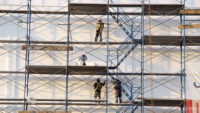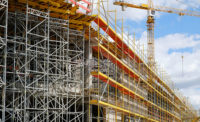2019 top standards- OSHA Most Frequently Violated Standards
OSHA scaffolding standard
Scaffolding (1926.451) OSHA’s scaffolding standard for construction was the third most-frequently cited agency standard in FY 2018.

Enforcement citations FY 2018: 2,832
Number of inspections: 1,423
Proposed penalties: $7,163,515
Most frequently cited industries
- Construction
- Wholesale trade
- Waste management and remediation services
- Manufacturing
- Real estate and rental and leasing
- Arts, entertainment and recreation
- Services
Enforcement case study
On September 24, 2013, OSHA proposed $272,720 in fines against four New York contractors for safety hazards identified during the construction of a midtown Manhattan hotel. The March 21, 2013 inspection was conducted in response to a complaint about fall hazards at the 325 W. 33rd St. work site.
The largest penalties of $249,920 were proposed for Flintlock Construction Services LLC, the Mamaroneck-based general contractor for the construction of the 23-story hotel. Flintlock was cited for seven violations of OSHA’s fall protection and scaffolding standards that involved workers exposed to potentially fatal falls of up to 26 feet while they were on scaffolding.
“These employees were one trip, slip or misstep away from a deadly or disabling fall. Falls are the leading cause of death among workers in construction,” said Kay Gee, OSHA’s area director for Manhattan, Brooklyn and Queens. "There is no excuse for an employer’s failure to supply and ensure the use of legally required safeguards that can prevent injuries and save lives. The sizable fines proposed reflect both the severity of these hazards and that Flintlock was aware of, and failed to correct, the hazards.”
Specifically, Flintlock failed to provide and ensure the use of fall protection, such as guardrails or personal fall- arrest systems, for workers on the scaffold; the scaffold lacked a safe means of access, causing workers to climb its cross-bracing to reach their work platforms; the work platforms were not fully planked; and the scaffold was not tied off to restrain it from tipping. These conditions resulted in the issuance of four willful citations, with $233,200 in fines to Flintlock.
OSHA also issued three serious citations, with $16,720 in fines, to Flintlock for additional hazards. These include failing to provide training on the hazards associated with erecting scaffolds; failing to have a competent person determine the feasibility of providing fall protection for workers erecting and dismantling the scaffolding; a scaffold walkway that was too narrow; and inadequate anchorage for the fall protection system.
V&P Altitude Corp., a Brooklyn-based siding contractor, was issued five serious citations, with $13,200 in fines, for lack of fall protection; no safe access to the scaffolding; not fully planking the scaffold platforms; failing to tie off the scaffolding; and not locking mobile scaffold wheels and casters.
SMK Associates, an Astoria-based masonry contractor, was issued three serious citations, with $7,600 in fines, for electrical hazards and failing to provide eye and face protection. Maspeth Steel Fabricators Inc., a Maspeth-based steel framing contractor, was issued one serious citation, with a $2,000 fine, for failing to provide training on the hazards of working on scaffolds.
Background
The Bureau of Labor Statistics’ Census of Fatal Occupational Injuries (CFOI) reported 54 fatalities occurred in the year 2009 from scaffold staging. In a Bureau of Labor and Statistics (BLS) study, 72 percent of workers injured in scaffold accidents attributed the accident either to the planking or support giving way, or to the employee slipping or being struck by a falling object. All of these can be controlled by compliance with OSHA standards.
Hazard protection
A scaffold is an elevated, temporary work platform. There are two basic types of scaffolds:
- Supported scaffolds, which consist of one or more platforms supported by rigid, load- bearing members, such as poles, legs, frames, outriggers, etc.
- Suspended scaffolds, which are one or more platforms suspended by ropes or other non-rigid, overhead support.
- Other types of equipment, principally scissor lifts and aerial lifts, can be regarded as other types of supported scaffolds.
Common hazards associated with all scaffolds include:
- Falls from elevation, due to lack of fall protection;
- Collapse of the scaffold, caused by instability or overloading;
- Being struck by falling tools, work materials, or debris;
- Electrocution, due to the proximity of the scaffold to overhead power lines.
Employers must provide fall protection for each employee on a scaffold more than 10 feet (3.1 m) above a lower level.
A competent person must determine the feasibility and safety of providing fall protection for employees erecting or dismantling supported scaffolds.
Fall-arrest and guardrail systems must be used when working on single- and two-point adjustable suspension scaffolds and self-contained adjustable scaffolds that are supported by ropes.
Shore and lean-to scaffolds are strictly prohibited.
Employees are prohibited from working on scaffolds covered with snow, ice, or other slippery materials - except to remove these substances.
Employers must provide access when the scaffold platforms are more than 2 feet (0.6 m) above or below a point of access.
Direct access is acceptable when the scaffold is not more than 14 inches (36 cm) horizontally and not more than 24 inches (61 cm) vertically from the other surfaces.
The standard prohibits the use of crossbraces as a means of access.
Key scaffolding standard takeaways
- Each scaffold and scaffold component must support without failure its own weight and at least 4 times the maximum intended load applied or transmitted to it.
- A qualified person must design the scaffolds, which are loaded in accordance with that design.
- Scaffolds and scaffold components must not be loaded in excess of their maximum intended loads or rated capacities, whichever is less.
- Load carrying timber members should be a minimum of 1,500 lb-f/in2 construction grade lumber.
- Each platform must be planked and decked as fully as possible with the space between the platform and uprights not more than 1 inch (2.5 cm) wide. The space must not exceed 9½ inches (24.1 cm) when side brackets or odd-shaped structures result in a wider opening between the platform and the uprights.
- The standard requires employers to protect each employee on a scaffold more than 10 feet (3.1 m) above a lower level from falling to that lower level. To ensure adequate protection, install guardrails along all open sides and ends before releasing the scaffold for use by employees, other than the erection and dismantling crews.
- Guardrails are not required, however:
- When the front end of all platforms are less than 14 inches (36 cm) from the face of the work. When outrigger scaffolds are 3 inches (8 cm) or less from the front edge,
- When employees are plastering and lathing 18 inches (46 cm) or less from the front edge.
Compliance resources
- OSHA’s scaffolding eTool includes FAQs, glossary, hazards and possible solutions for many types of scaffolding.
- Narrow Frame Scaffolds. OSHA Fact Sheet (Publication 3722), (April 2014).
- Using Aerial Lifts. OSHA Fact Sheet, (October 2005).
Looking for a reprint of this article?
From high-res PDFs to custom plaques, order your copy today!






